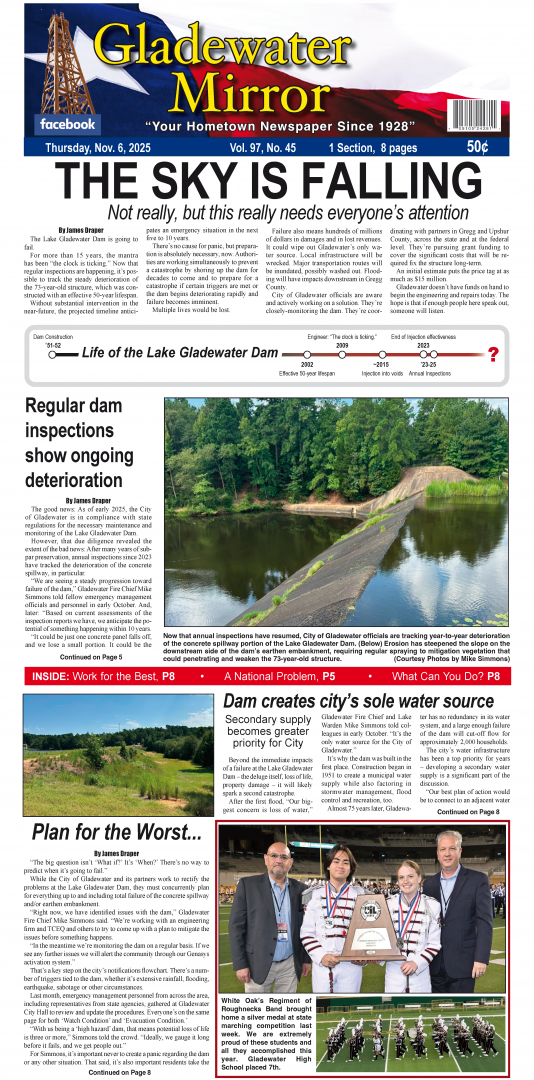City’s priorities include developing secondary supply
This is the THIRD in a series of stories focused on the Lake Gladewater Dam and published in the Nov. 6 issue of the Gladewater Mirror |
Part 1: The Sky is Falling
Part 2: Regular dam inspections show ongoing deterioration
Part 3: Gladewater dam creates community’s sole water source
Part 4: Plan for the Worst…
Part 5: …Work for the Best
Part 6: What can you do?
Part 7: Aging dams become common problem for U.S. communities
Add’l: Lake Gladewater Dam (Landscape Ecology assessment by E. Simpson, Aug. 2, 2024)
Beyond the immediate impacts of a failure at the Lake Gladewater Dam – the deluge itself, loss of life, property damage – it will likely spark a second catastrophe.
After the first flood, “Our biggest concern is loss of water,” Gladewater Fire Chief and Lake Warden Mike Simmons told colleagues in early October. “It’s the only water source for the City of Gladewater.”
It’s why the dam was built in the first place. Construction began in 1951 to create a municipal water supply while also factoring in stormwater management, flood control and recreation, too.
Almost 75 years later, Gladewater has no redundancy in its water system, and a large enough failure of the dam will cut-off flow for approximately 2,000 households.
The city’s water infrastructure has been a top priority for years – developing a secondary water supply is a significant part of the discussion.
“Our best plan of action would be to connect to an adjacent water supply,” according to Water Plant Manager Wendy Emmel. “That way, we could open the valve in the something happens and supply treated water.”
It’s a requirement, she added, one that the city has never fulfilled.
One option would be to coordinate with White Oak toward tapping the neighboring community’s water line from Big Sandy Creek.
Another option, Gladewater City Manager Charlie Smith said, might be to partner with the City of Longview and run a line to tie into that system for emergencies.
Currently, the water reserve’s just eight hours. Accepting that land acquisition would be pricey, a raw water reservoir outside Gladewater could make for a short-term solution
“Two million gallons would sustain us for one day,” Emmel said.
Meanwhile, Lake Gladewater needs to be dredged. It hasn’t happened in about 25 years, she noted, but rough plans are already on the drawing board.
It’s one of many projects in the works.
“We’ve been fixing so many broken things,” Smith said, repairing and, whenever possible, upgrading one section of the water system at a time. The development of a secondary water source is climbing higher up the list: “Honestly, I don’t think it was really taken seriously in the past.”
It’s one more thing to consider in mitigating risks related to the dam, Simmons said.
“We don’t have an alternative source. We don’t have another connection to another city,” he added. A healthy, functional dam is essential until a backup supply is in place. For the immediate future, “We have to make the water out of that lake. If it’s not there, we can’t.”
– By JAMES DRAPER









